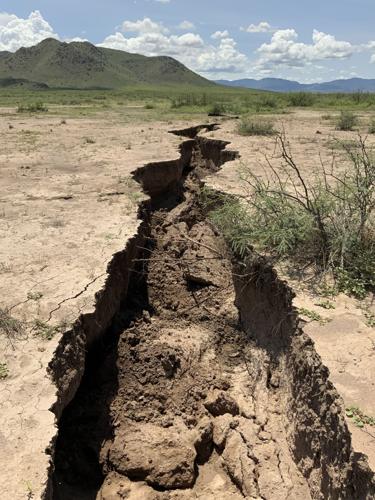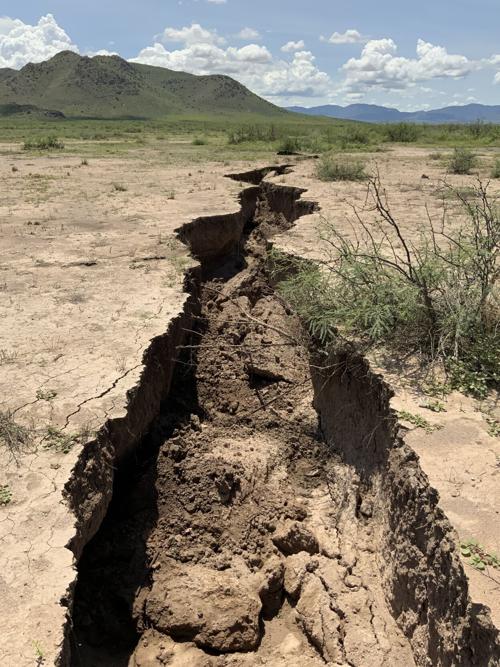We can try to ignore water issues, but they will crack open our minds and flow into our consciousness one way or another.
Recently in Cochise County, water has demanded it be noticed by making fissures and floods.
As my colleague Tony Davis reported over the weekend, fissures have been opening up in the agricultural areas of the county in Arizona’s southeast corner. These cracks in the ground, up to a half-mile long and reaching depths of 16 feet or more, have damaged roads, forcing closures and long detours.
A fissure closed U.S. Highway 191, the main north-south drag in the Sulphur Springs Valley, for a week this summer.
But road closures are just a short-term inconvenience. What the fissures are really telling us is that people are pumping too much water for all the proliferating farms in the region.
When the groundwater level drops, the water no longer binds the soil together, and it can collapse. The recent summer storms have hastened the process, chiseling out fissures in the unbound soil.
The storms also proved the folly of walling off washes. In a part of Cochise County southeast of where the fissures have formed, heavy rains forced open and damaged huge gates in the expensive new border wall.
Drone footage taken by John Kurc shows five massive gates in the new border wall open, at least one of them torn off its hinges completely, thanks to flooding last week. It occurred where Silver Creek, normally a dry wash, crosses the border, just west of the San Bernardino National Wildlife refuge and about 17 miles east of Douglas.
This was completely predictable – and widely predicted – as federal contractors threw up the wall during the last year of Trump’s presidency. It was folly to think storms wouldn’t eventually tear apart any pieces of wall that cross washes.
A political agenda required that the wall be built, though, and federal law allowed environmental regulations to be waived for the construction.
The water did not know or abide — it just fell and flowed and knocked things over. You can waive environmental laws, but not the laws of nature.
A similar challenge to the laws of nature has been going on for decades, accelerating in recent years, in the Sulphur Springs Valley. Because state law does not regulate groundwater pumping outside the five “active management areas” and three “irrigation non-expansion areas,” big corporate agribusinesses have flocked to the Willcox area.
They can plant their pecan or fruit trees and plunge wells deep into the ground to tap the water down there for irrigation. They can afford to go much deeper than local farmers and residents can.
Various efforts have been made over the years to put some kind of regulation on groundwater use in the area, but they have tended to fall apart at the state Legislature. In fact, state Sen. Gail Griffin, who has served in both the House and Senate, has blocked efforts to consider regulations, such as a plan to let counties establish “rural management areas.”
The utter failure to grapple with groundwater has led some Cochise County residents to make an unprecedented move. They are collecting signatures to force a vote on whether the Willcox and Douglas basins of the valley should become active management areas.
This process has been in the law since 1980, when the state’s groundwater management act went into effect, but it has never been used. It would force the Arizona Department of Water Resources to manage groundwater in the area, with local input.
“If we take this directly to the ballot and we vote on it, at least in that way it’s our judgment in the end. It’s not putting our faith in the lawmakers,” said Beau Hodai, one of the leaders of the new group called Arizona Water Defenders that is leading the initiative.
The group needs to collect 1,346 signatures of voters from the Douglas basin and 662 from voters in the Willcox basin by July 7, 2022. If they succeed, the AMA proposal will be on the ballot in November 2022.
Peggy Judd, the Cochise County supervisor who represents most of the affected area, told me she leans against the effort to designate active management areas, but she has moderated her former position against regulation of groundwater in the Willcox area.
“I’m hoping we can get some sort of control on the water use in our valley,” she said. “I’m not against regulation. I’m not afraid of regulation. I think it’s needed.”
This is what happens when water shows it is ignoring all of our illusions. People’s minds eventually open to reality and are forced to change.
It’s happening in Cochise County now — but undoubtedly will force us into a reckoning in Tucson and the rest of Arizona, too.







